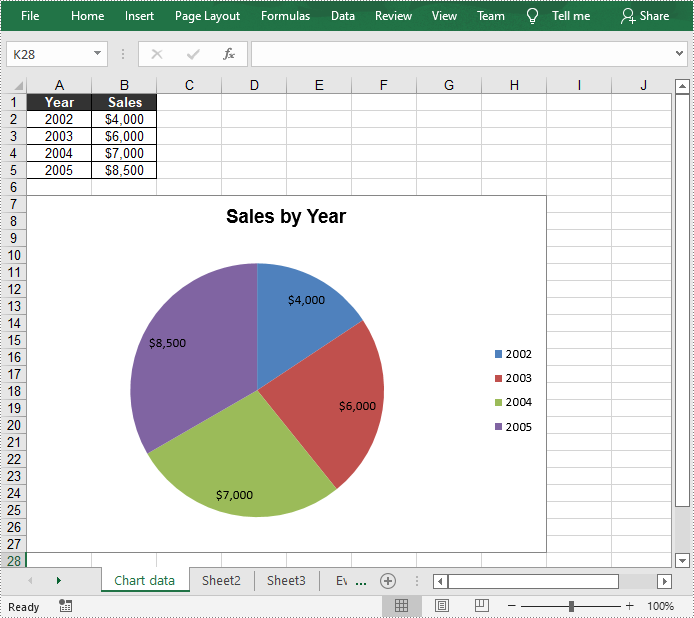A pie chart is a circular chart for visually representation of data. It divides a circular statistical graph into sectors or slices and each sector represents a specific portion of the total percentage. In this article, you will learn how to programmatically create a pie chart in Excel using Spire.XLS for .NET.
Install Spire.XLS for .NET
To begin with, you need to add the DLL files included in the Spire.XLS for .NET package as references in your .NET project. The DLL files can be either downloaded from this link or installed via NuGet.
PM> Install-Package Spire.XLS
Create a Pie Chart in Excel
The detailed steps are as follows:
- Create a Workbook instance.
- Get a specified worksheet using Workbook.Worksheets[sheetIndex] property.
- Add some data to specified cells and set the cell styles and borders.
- Add a pie chart to the worksheet using Worksheet.Charts.Add(ExcelChartType.Pie) method.
- Set data range for the chart using Chart.DataRange property.
- Set the position and title of the chart.
- Get a specified series in the chart and set category labels and values for the series using ChartSerie.CategoryLabels and ChartSerie.Values properties.
- Show data labels for data points by setting the ChartSerie.DataPoints.DefaultDataPoint.DataLabels.HasValue property as true.
- Save the result file using Workbook.SaveToFile() method.
- C#
- VB.NET
using Spire.Xls;
using Spire.Xls.Charts;
using System.Drawing;
namespace CreatePieChart
{
class Program
{
static void Main(string[] args)
{
//Create a Workbook instance
Workbook workbook = new Workbook();
//Get the first worksheet
Worksheet sheet = workbook.Worksheets[0];
//Set sheet name
sheet.Name = "Chart data";
//Add data to specified cells
sheet.Range["A1"].Value = "Year";
sheet.Range["A2"].Value = "2002";
sheet.Range["A3"].Value = "2003";
sheet.Range["A4"].Value = "2004";
sheet.Range["A5"].Value = "2005";
sheet.Range["B1"].Value = "Sales";
sheet.Range["B2"].NumberValue = 4000;
sheet.Range["B3"].NumberValue = 6000;
sheet.Range["B4"].NumberValue = 7000;
sheet.Range["B5"].NumberValue = 8500;
//Set cell styles
sheet.Range["A1:B1"].Style.Font.IsBold = true;
sheet.Range["A1:B1"].Style.KnownColor = ExcelColors.Black;
sheet.Range["A1:B1"].Style.Font.Color = Color.White;
sheet.Range["A1:B5"].Style.HorizontalAlignment = HorizontalAlignType.Center;
sheet.Range["A1:B5"].Style.VerticalAlignment = VerticalAlignType.Center;
//Set number format
sheet.Range["B2:C5"].Style.NumberFormat = "\"$\"#,##0";
//Set cell borders
sheet.Range["A1:B5"].Style.Borders[BordersLineType.EdgeTop].Color = Color.FromArgb(0, 0, 128);
sheet.Range["A1:B5"].Style.Borders[BordersLineType.EdgeTop].LineStyle = LineStyleType.Thin;
sheet.Range["A1:B5"].Style.Borders[BordersLineType.EdgeBottom].Color = Color.FromArgb(0, 0, 128);
sheet.Range["A1:B5"].Style.Borders[BordersLineType.EdgeBottom].LineStyle = LineStyleType.Thin;
sheet.Range["A1:B5"].Style.Borders[BordersLineType.EdgeLeft].Color = Color.FromArgb(0, 0, 128);
sheet.Range["A1:B5"].Style.Borders[BordersLineType.EdgeLeft].LineStyle = LineStyleType.Thin;
sheet.Range["A1:B5"].Style.Borders[BordersLineType.EdgeRight].Color = Color.FromArgb(0, 0, 128);
sheet.Range["A1:B5"].Style.Borders[BordersLineType.EdgeRight].LineStyle = LineStyleType.Thin;
//Add a pie chart to the worksheet
Chart chart = sheet.Charts.Add(ExcelChartType.Pie);
//Set data range for the chart
chart.DataRange = sheet.Range["B2:B5"];
chart.SeriesDataFromRange = false;
//Set position of the chart
chart.LeftColumn = 1;
chart.TopRow = 7;
chart.RightColumn = 9;
chart.BottomRow = 28;
//Set and format chart title
chart.ChartTitle = "Sales by Year";
chart.ChartTitleArea.IsBold = true;
chart.ChartTitleArea.Size = 14;
// Get a specified series in the chart
ChartSerie cs = chart.Series[0];
//Set category labels for the series
cs.CategoryLabels = sheet.Range["A2:A5"];
//Set values for the series
cs.Values = sheet.Range["B2:B5"];
// Show data labels for data points
cs.DataPoints.DefaultDataPoint.DataLabels.HasValue = true;
//Save the result file
workbook.SaveToFile("PieChart.xlsx", ExcelVersion.Version2016);
}
}
}

Apply for a Temporary License
If you'd like to remove the evaluation message from the generated documents, or to get rid of the function limitations, please request a 30-day trial license for yourself.

